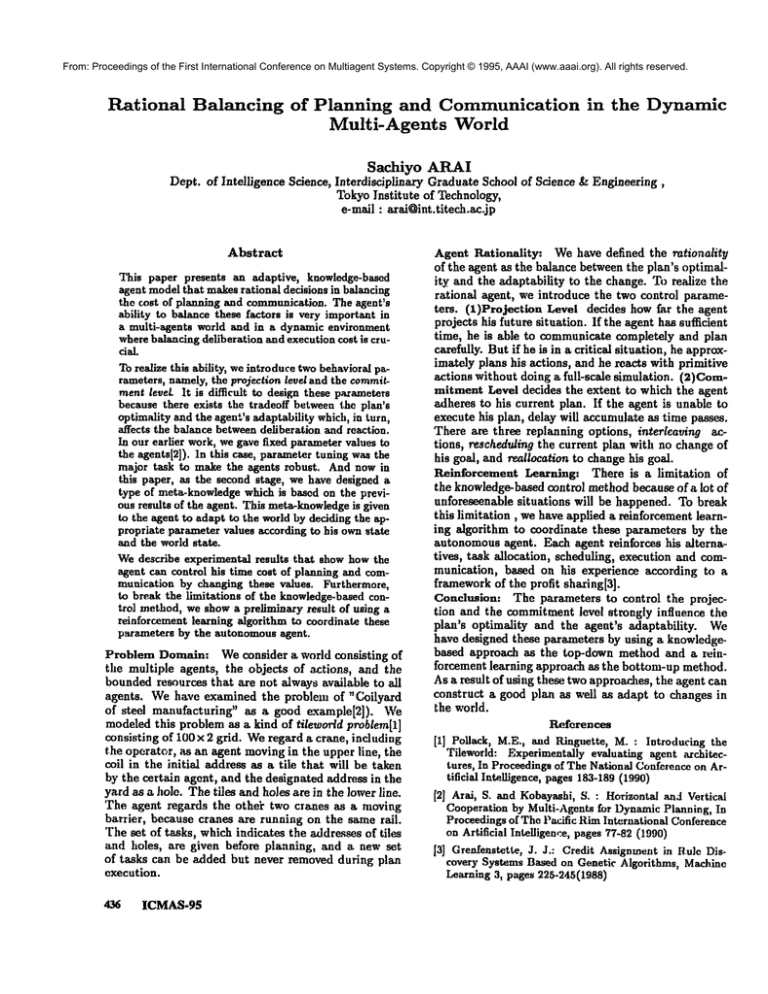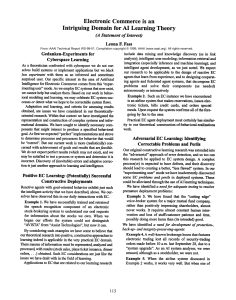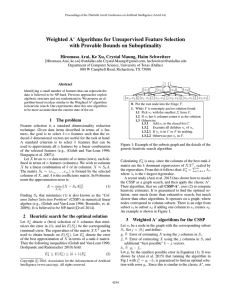
From: Proceedings of the First International Conference on Multiagent Systems. Copyright © 1995, AAAI (www.aaai.org). All rights reserved.
Rational
Balancing
of
Planning
and
Multi=Agents
Sachiyo
Communication
World
in
the
Dynamic
ARAI
Dept. of Intelligence Science, Interdisciplinary Graduate School of Sc/ence & Engineering,
TokyoInstitute of Technology,
e-mail : arai@int.titech.ac.jp
Abstract
This paper presents an adaptive, knowledge-based
agent modelthat makesrational decisions in balancing
the cost of planning and communication.The agent’s
ability to balance these factors is very important in
a multi-agents world and in a dynamic environment
wherebalancingdeliberation and executioncost is crucial.
To realize this ability, we introducetwobehavioral parameters, namely,the projection level and the commitment leveL It is difficult to design these parameters
because there exists the tradeoff between the plan’s
optimality and the agent’s adaptability which, in turn,
affects the balance betweendeliberation and reaction.
In our earlier work, we gave fixed parametervalues to
the agents[2]). In this case, parametertuning was the
major task to make the agents robust. And now in
this paper, as the second stage, we have designed a
type of meta-knowledgewhich is based on the previous results of the agent. This meta~knowledge
is given
to the agent to adapt to the world by deciding the appropriate parameter values according to his ownstate
and the world state.
Wedescribe experimental results that showhow the
agent can control his time cost of planning and communication by changing these values. Furthermore,
to break the limitations of the knowledge-basedcontrol method, we showa preliminary result of using a
reinforcement learning algorithm to coordinate these
parameters by the autonomousagent.
Problem Domain: We consider a world consisting of
the multiple agents, the objects of actions, and the
boundedresources that are not always available to all
agents. Wehave examined the problem of "Coilyard
of steel manufacturing" as a good example[2]). We
modeledthis problem as a kind of tileworld problem[l]
consisting of 100 × 2 grid. Weregard a crane, including
the operator, as an agent movingin the upper line, the
coil in the initial address as a tile that will be taken
by the certain agent, and the designated address in the
yard as a hole. The tiles and holes are in the lower line.
The agent regards the othe~ two cranes as a moving
barrier, because cranes are running on the same rail.
"[’lie set of tasks, whichindicates the addresses of tiles
and holes, are given before planning, and a new set
of tasks can be added but never removed during plan
execution.
436
ICMAS-g$
Agent l~tionallty:
Wehave defined the rationality
of the agent as the balance between the plan’s optimality and the adaptability to the change. To realize the
rational agent, we introduce the two control parameters. (1)Projection Level decides how far the agent
projects his future situation. If the agent has sufficient
time, he is able to communicate completely and plan
carefully. But if he is in a critical situation, he approximately plans his actions, and he reacts with primitive
actions without doing a full-scale simulation. (2)Commitment Level decides the extent to which the agent
adheres to his current plan. If the agent is unable to
execute his plan, delay will accunmlate as time passes.
There are three replanning options, inter[caving actions, rescheduling the current plan with no change of
his goal, and re.allocation to changehis goal.
Reinforcement Learning: There is a limitation of
the knowledge-basedcontrol methodbecause of a lot of
unforeseenable situations will be happened. To break
this limitation, we have applied a reinforcement learning algorithm to coordinate these parameters by the
autonomousagent. Each agent reinforces his alternatives, task allocation, scheduling, execution and communication, based on his experience according to a
frameworkof the profit sharing[3].
Conclusion: The parameters to control the projection and the commitmentlevel strongly influence the
plan’s optimality and the agent’s adaptability.
We
have designed these parameters by using a knowledgebased approach as the top-down method and a reinforcement learning approach as the bottom-up method.
As a result of using these two approadles, the agent can
construct a good plan as well as adapt to changes in
the world.
References
[1] Pollack, M.E., and rtinguette~ M. : Introducing the
Tileworld: Experimental]y evaluating agent architectures, In Proceedingsof The National Conferenceon Artificial Intelligence, pages183-189(1990)
[2] Arai, S. and Kobayashi,S. : Horizontal an~l Vertical
Cooperation by Multi-Agents for DynamicPlanning, In
Proceedingsof The Pacific RimInternational Conference
on Artificial Intelligence, pages77-82(1990)
[3] Grenfenstette, J. J.: Credit Assignmentin Rule Discovery Systems Based on Genetic Algorithms, Machine
Learning 3, pages 225-245(1988)










